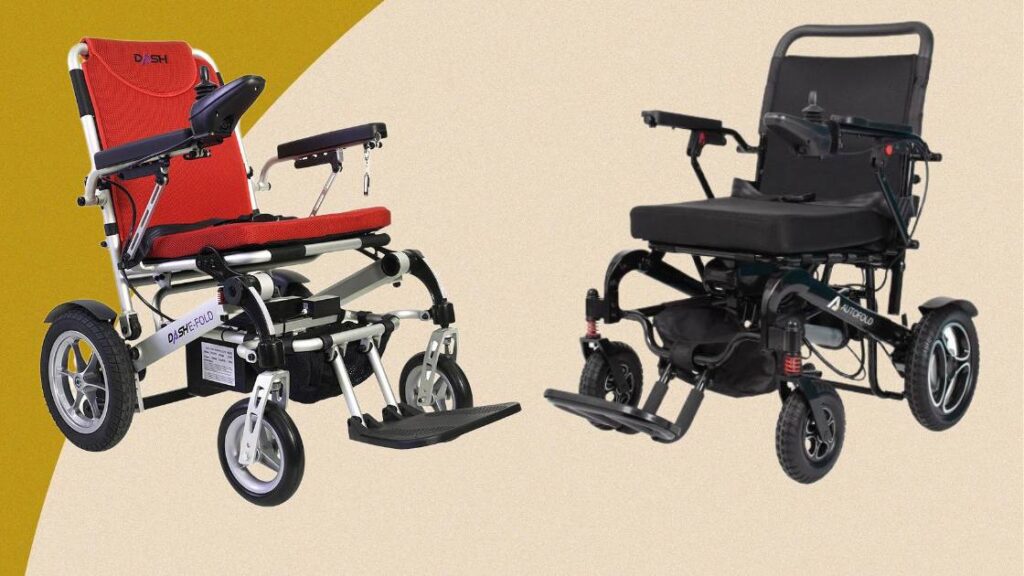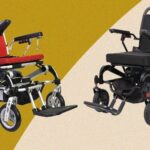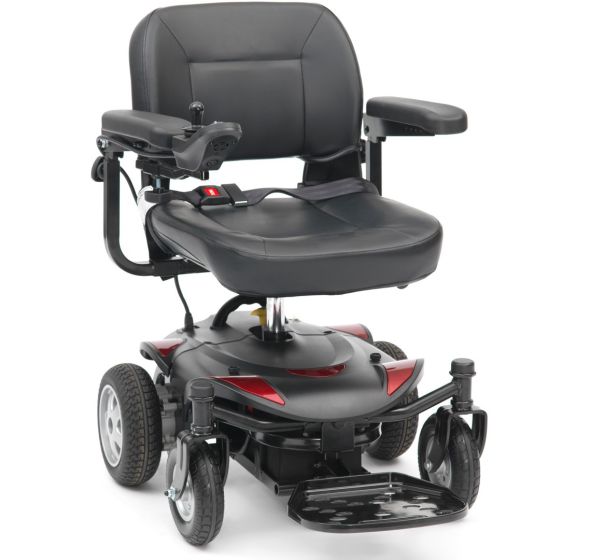
Imagine a world where limited mobility doesn't have a problem with exploring, socializing, and embracing life's adventures. Electric wheelchairs have revolutionized the way individuals with physical disabilities navigate the world around them, empowering them with newfound freedom and independence. In this comprehensive guide, we will explore everything that you need to know about electric wheelchairs, unveiling their remarkable types, features, benefits, and the transformative impact they have on the lives of their users.
Electric Wheelchair
An electric wheelchair, also known as a power wheelchair or motorized wheelchair, is a mobility device powered by an electric motor. It is designed to assist individuals with limited mobility or physical disabilities in moving around independently. Unlike manual wheelchairs that require physical effort to propel, electric wheelchairs are operated using a joystick or control panel, allowing the user to manoeuvre the wheelchair with ease.
Electric wheelchairs typically have a battery pack that provides the power for the electric motor. The battery can be recharged by plugging it into a power outlet. The motor drives the wheels of the wheelchair, enabling the user to move forward, backwards, turn, and navigate different terrains.
Electric wheelchairs offer several benefits, including increased mobility and independence for individuals who have difficulty walking or operating a manual wheelchair. They are equipped with various features such as adjustable seating, reclining capabilities, and additional accessories for comfort and convenience.
Electric wheelchairs come in different models and sizes to cater to individual needs. Some models are designed for indoor use, offering manoeuvrability in tight spaces, while others are more robust and suitable for outdoor use, with enhanced stability and all-terrain capabilities.
Different types of Electric Wheelchairs
There are several types of electric wheelchairs available, each designed to cater to different needs and preferences. Here are some common types of electric wheelchairs:
- Standard Electric Wheelchair: These wheelchairs are suitable for indoor and outdoor use and offer basic features such as joystick control, adjustable seating, and manoeuvrability in tight spaces.
- Folding Electric Wheelchair: These wheelchairs are designed to be compact and easily foldable, making them convenient for transportation and storage. They are lightweight and often feature removable battery packs for easy handling.
- All-Terrain Electric Wheelchair: These wheelchairs are built to navigate rough terrains and outdoor environments. They typically have larger wheels with improved traction, robust suspension systems, and sturdy frames for enhanced stability and manoeuvrability.
- Travel Electric Wheelchair: These wheelchairs are lightweight and compact, specifically designed for easy transportation during travel. They are often foldable and feature detachable components to fit into car trunks or aircraft storage compartments.
- Bariatric Electric Wheelchair: Bariatric electric wheelchairs are designed for individuals who require higher weight capacities. They have sturdy frames and wider seats to accommodate larger individuals comfortably.
- Standing Electric Wheelchair: These wheelchairs provide the ability to transition from a seated position to a standing position. They can offer various health benefits such as improved blood circulation, pressure relief, and greater independence.
- Pediatric Electric Wheelchair: Designed for children, these wheelchairs offer age-appropriate sizes, adjustable seating systems, and safety features suitable for pediatric users.
- Tilt-in-Space Electric Wheelchair: These wheelchairs have a seating system that can tilt backwards while maintaining the user's position relative to the ground. This feature aids in pressure relief, weight redistribution, and positioning for individuals with specific medical needs.
- Outdoor Recreational Electric Wheelchair: These wheelchairs are designed for individuals who want to participate in outdoor recreational activities such as off-road adventures, beach trips, or sports. They often feature rugged frames, powerful motors, and specialized tires for optimal performance in outdoor settings.
Electric wheelchairs may vary depending on the manufacturer and local suppliers. It's recommended to consult with healthcare professionals or mobility equipment providers like us to determine the most suitable type of electric wheelchair based on individual needs and preferences. You can also consult with our mobility experts who will guide you to find your suitable Electric Wheelchair.
How much does an Electric Wheelchair cost?
The costs of electric wheelchairs can range from around £1,000 to £15,000, depending on factors such as the brand, model, size, features, and where you purchase it. Here are some of the factors that can affect the prices of electric wheelchairs:
- Features: The more features a wheelchair has, the more expensive it will be. Some common features that can affect the price include:
- Speed: The faster a wheelchair can go, the more expensive it will be.
- Range: The longer a wheelchair can travel on a single charge, the more expensive it will be.
- Weight: The lighter a wheelchair is, the more expensive it will be.
- Folding: A folding wheelchair is more convenient to transport, but it will also be more expensive.
- Size: Larger wheelchairs are more expensive than smaller wheelchairs.
- Brand: Some brands of electric wheelchairs are more expensive than others.
- Quality: The quality of the materials and construction of an electric wheelchair can also affect the price.
If you are on a budget, there are a number of affordable electric wheelchairs available at our Mobility Shop. These chairs may not have all of the features or quality of more expensive models. If you have specific needs or requirements, it is important to speak with our mobility expert to find the right electric wheelchair for you.
Here are some examples of the price of electric wheelchairs:
- Basic electric wheelchair: £1,000 - £2,000
- Mid-range electric wheelchair: £2,000 - £4,000
- High-end electric wheelchair: £4,000 - £15,000
What are electric wheelchairs called?
Electric wheelchairs are also known as power wheelchairs or motorized wheelchairs. These terms are used interchangeably and refer to the same type of wheelchair that is propelled by an electric motor rather than by the user's own muscle power.
Electric wheelchairs are also referred to by several other names, including:
- Power Chairs
- Battery-powered wheelchair
- Electric mobility chair
- Motorized mobility device
- Electric power chair
- Powered Wheelchair
What are the benefits of an Electric Wheelchair?
Electric wheelchairs offer several benefits that can greatly enhance the mobility and independence of individuals with mobility impairments. Here are some key benefits of using an electric wheelchair:
- Increased Independence: Electric wheelchairs empower individuals with limited mobility to move around independently without relying on others for assistance. They can navigate various environments and perform daily activities with greater freedom and autonomy.
- Ease of Use: Electric wheelchairs are generally easy to operate, especially for individuals with limited upper body strength or dexterity. They typically feature intuitive controls, such as a joystick, making them accessible to a wide range of users.
- Reduced fatigue: Electric wheelchairs can help to reduce fatigue, as users do not have to use their own muscle power to propel the chair. This can be especially beneficial for people with chronic health conditions or disabilities that make it difficult to use a manual wheelchair.
- Long-Distance Travel: Electric wheelchairs enable users to cover longer distances comfortably and efficiently. They offer consistent and reliable power, allowing individuals to navigate through neighbourhoods, parks, and shopping centres, or even travel long distances without the fatigue of manual propulsion.
- Enhanced Maneuverability: Electric wheelchairs often have a smaller turning radius and better manoeuvrability compared to manual wheelchairs. This enables users to navigate tight spaces, hallways, and crowded areas with ease, providing greater accessibility in various indoor and outdoor environments.
- Customizable Features: Many electric wheelchairs come with customizable seating options, including adjustable seat height, backrest angle, and leg rest positions. This allows users to find a comfortable and supportive seating position tailored to their specific needs and preferences.
- Safety and Stability: Electric wheelchairs are designed with safety features such as anti-tip wheels, automatic braking systems, and stability-enhancing mechanisms. These features provide stability and security, reducing the risk of tipping over or accidents.
- Improved Social Interaction: By offering increased mobility and independence, electric wheelchairs can help individuals participate in social activities and engage with their surroundings more actively. This can have a positive impact on mental well-being and overall quality of life.
- Accessibility in Various Environments: Electric wheelchairs, including all-terrain models, allow users to navigate different terrains like climbing hills and other surfaces, such as gravel, grass, or uneven pathways. This expands accessibility and enables individuals to enjoy outdoor activities and explore new environments.
Benefits may vary depending on the individual's needs, the model of the electric wheelchair, and the environment in which it is used. Consulting with healthcare professionals or our mobility experts can help you determine the most suitable electric wheelchair to maximize the benefits based on individual circumstances.
How does an Electric Wheelchair work?
An electric wheelchair works through a series of motors, which are powered by electric, rechargeable batteries, and controlled through a joystick by a user or carer. Here is a general overview of how an electric wheelchair works:
- Electric Motor: The wheelchair is equipped with an electric motor that is powered by a rechargeable battery pack. The motor provides the necessary power to move the wheelchair.
- Control System: The wheelchair has a control system that allows the user to operate and control the movement of the wheelchair. It typically consists of a joystick, control panel, or other input devices that the user can manipulate to control the speed, direction, and other functions of the wheelchair.
- Battery Pack: The electric motor is powered by a battery pack, usually located beneath the seat or on the back of the wheelchair. The battery pack is rechargeable and provides the necessary electrical energy to drive the motor.
- Drive System: The electric motor is connected to the wheels of the wheelchair through a drive system. The drive system may use gears, belts, or direct drive mechanisms to transfer the power from the motor to the wheels.
- Steering and Direction Control: The control system allows the user to steer and control the direction of the wheelchair. By manipulating the joystick or control panel, the user can navigate the wheelchair forward, backwards, and turn left or right.
- Safety Features: Electric wheelchairs are equipped with various safety features to ensure the user's safety and prevent accidents. These features may include anti-tip wheels, automatic braking systems, speed control, and obstacle detection sensors.
- Recharging: The battery pack of the wheelchair needs to be recharged regularly. Typically, the wheelchair is connected to a power outlet using a charging cable, and the battery pack is recharged overnight or as needed.
Specific features and operation of an electric wheelchair may vary depending on the model and manufacturer. Some advanced electric wheelchairs may also include additional features such as seat elevation, tilt-in-space, and power seating functions for enhanced comfort and functionality.
Are electric wheelchairs safe?
Electric wheelchairs can be safe when used properly and according to the manufacturer's instructions. However, their safety depends on several factors, including the design and construction of the wheelchair, the user's abilities and understanding of its operation, and adherence to safety guidelines. Here are some key points to consider regarding the safety of electric wheelchairs:
- Design and Quality: Electric wheelchairs manufactured by reputable brands and meeting safety standards are generally considered safe. Look for wheelchairs with safety features like anti-tip wheels, seatbelts, and speed controls.
- Training and Familiarity: Users must be properly trained in operating the electric wheelchair. Understanding how to start, stop, turn, and use safety features is crucial to avoiding accidents.
- Stability and Anti-Tip Features: Electric wheelchairs are designed to be stable, but users should be cautious when navigating steep slopes, curbs, or uneven terrain. Anti-tip wheels can help prevent tipping backwards on steep inclines.
- Speed Control: Most electric wheelchairs come with speed controls or adjustable settings. Beginners should start with lower speeds until they gain confidence in handling the wheelchair.
- Environmental Awareness: Users should be aware of their surroundings to avoid collisions with obstacles, people, or vehicles as Electric wheelchairs can travel at speeds of up to 8 mph, which can be dangerous if they collide with another person or object.
- Regular Maintenance: Regular maintenance of the electric wheelchair is essential to ensure its safe operation. This includes checking the battery, brakes, and other components.
- Proper Use: Avoid using the wheelchair for activities it is not designed for, such as carrying heavy loads beyond its capacity or attempting to climb stairs.
- Seatbelt Usage: Always use the seatbelt provided with the electric wheelchair to prevent falling out during sudden stops or tip-overs.
- Battery Safety: Electric wheelchair batteries should be charged and used according to the manufacturer's instructions to avoid potential hazards.
- Transportation Safety: If the wheelchair needs to be transported in a vehicle, ensure it is securely fastened to prevent movement during transit.
- User Physical Condition: Users should be aware of their physical limitations and should not operate the wheelchair if they are feeling dizzy, disoriented, or unwell.
- Electrocution: Electric wheelchairs use batteries, which can pose a risk of electrocution if they are not properly maintained.
To reduce the risk of accidents, it is important to follow these safety tips when using an electric wheelchair:
- Obey all traffic laws.
- Always use the seat belt.
- Read the Owner's manual.
- Travel Outdoors Cautiously.
- Use carefully in Uneven Outdoor Terrain
- Turn the Chair Off When Getting In and Out.
- Use your horn or bell to signal your presence.
- Do not put overweight in an Electric wheelchair.
- Be aware of your surroundings and avoid obstacles.
- Have your wheelchair regularly inspected and maintained.
- Protect your Electric Wheelchair from water or getting wet.
- Keep your hands and feet inside the wheelchair at all times.
If you are considering using an electric wheelchair, it is important to talk to your doctor, certified rehabilitation professional or our mobility expert to make sure that it is the right choice for you. They can help you assess your individual needs and recommend an electric wheelchair that is safe and appropriate for your use.


